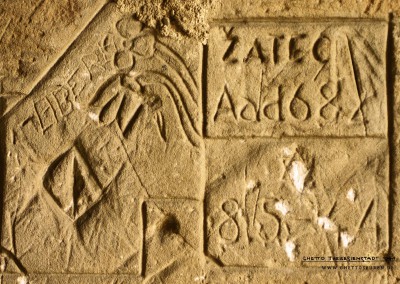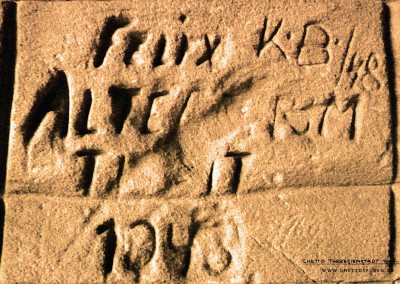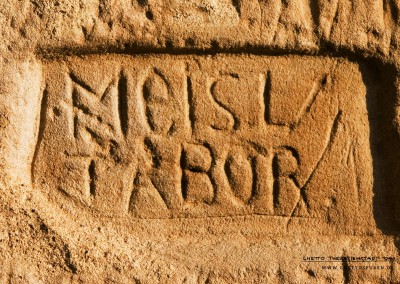Gallery I
Traces of Everyday Life in the Ghetto
How did prisoners live in the ghetto? What did their living spaces look like? How were their rooms furnished? Numerous traces and vestiges still found in Terezin provide answers. Often, only after a closer look do the historical traces become obvious: the demeaning living conditions, the struggle for daily survival and dying in the ghetto. The ghetto served primarily as a ghetto and transit camp for Jews; a temporary stop on their way to Auschwitz-Birkenau and other death camps in the East. This knowledge is crucial for understanding these silent witnesses and traces. They represent fragments of the backdrop against which a chapter of the “Final Solution” played out.
Gallery II
An Attic Full of Stories – L237
It is hard to imagine that this small attic room had to be shared by as many as four people. Prisoners, therefore, became resourceful, and even creative, when setting up their cramped abodes. Through their wall drawings and graffiti, they told stories of human trial: lovesickness, sleepless nights and longings for home. Yet, despite the indescribably atrocious hygienic conditions that made vermin a daily problem in the ghetto, humor could sometimes still prevail in the everyday lives of the prisoners, such as a Dutch author’s verse about an eternal plague of bedbugs.
The overall presentation of the following photographs provides a unique and, above all, close look into the lives of the prisoners who lived here. The viewer is given access to an unparalleled world, one rarely more than 10 square meters in size. It is all the more surprising that such a large quantity of graffiti and wall drawings could have gone undiscovered until 2014. This attic is only one of many such spaces where traces of ghetto life still exist. In the course of this project, we would also like to identify their authors and, if possible, document their fates. We will continually post our results on www.ghettospuren.de
Gallery III
Messages From the Past – Poterne III
After decades of military use, after debris was cleared and the fortress gate Poterne 3* was finally open in 2005, countless graffiti (stone wall carvings) that had been carved into the sandstone came to light. Among these are many whose meanings cannot be deciphered. The dates 1942, 1943 and 1944 are clear. We recognize symbols of hope and faith, signatures, transport numbers, names and dates.
Most of the authors were prisoners and members of the ghetto police who were themselves prisoners recruited to the service. For almost 70 years, the Poterne III kept its secrets. To date, none of these remnants from the past have received any attention. Our goal is to change this and attempt to reconstruct the lives of the authors. We plan to publish our detailed findings online at www.ghettospuren.de.
*According to Glossarium Artis: Poterne was a tunnel-shaped, often a vaulted passageway through a fortress wall providing cover for troops or transport of weapons, equipment and ammunition within a fortress.
Gallery IV
Attic Modifications – Necessity is the Mother of Invention
Most structural changes made between 1941 and 1945 were removed after the end of the war. Surprisingly, many traces, especially in the attics, were preserved until today. They offer clues of difficult living conditions in the ghetto. At the same time, they document prisoners’ ingenuity in utilizing materials within the complex conditions of the ghetto. We are trying to detect as many clues as possible from detailed photo documentation. We identify traces to learn more about them in the course of subsequent research.






















![These lines were written by a resident of this room. The verse, written with a pencil in Dutch, tells us about a sleepless night. “Oh bedbug, oh bedbug, oh thou ugly beast, thou dances all night upon me. I lie, the itching […] I feel you creeping. From head to my toes.” Bedbugs and fleas were a constant plague in the ghetto making nights unbearable for many of the prisoners. Although the ghetto’s Jewish self-administration made efforts to address the problem, the plague of bugs continued unabated.](https://ghettospuren.de/wp-content/uploads/L237_14-400x284.jpg)











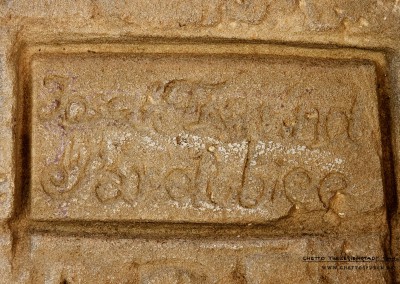
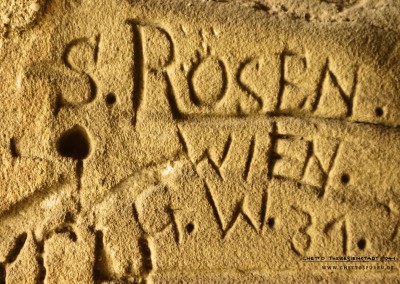


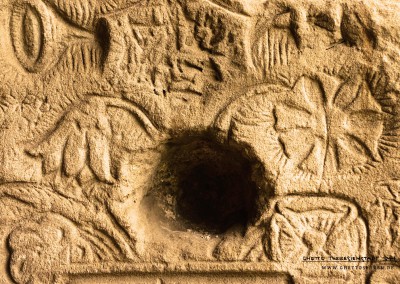
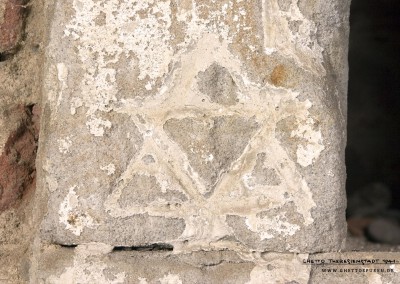
![Secret code: “AKB Mezina […] 628” is a coded message left behind by a prisoner. Although the author of the inscription did not leave his name, he did leave his transport number. Only Alfred Freund (born 29 November 1896 in Krchleby) comes into question. He arrived in Theresienstadt on a transport from České Budějovice (Budweis) on 18 April 1942. On 29 September 1944 he was deported to Auschwitz-Birkenau where he was killed. Carving MEZIMOS […] remains puzzling. Maybe it is a nickname or it stands for Mezimostí, a town’s name.](https://ghettospuren.de/wp-content/uploads/Poterne_10-400x284.jpg)
